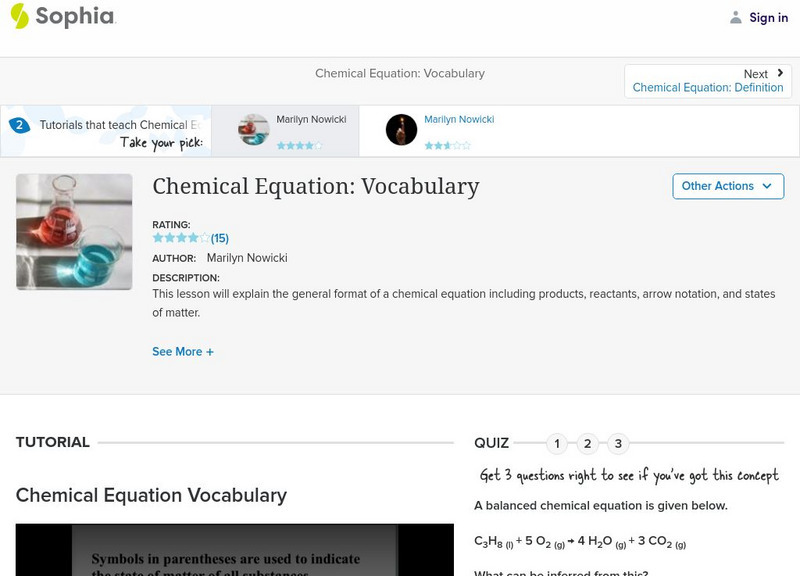Fuse School
Minerals and Ores
Here's a video that will leave them wanting m"ore"! Part three of the seven-part series involving rocks and the rock cycle illustrates the relationship between minerals and ores. Young geologists get a look at how valuable metals are...
Fuse School
Uses of Limestone - Cement, Mortar, and Concrete
This rock is on a roll! Introduce young geologists and environmentalists to the many uses of limestone using the fifth installment in a series of seven. Illustrate the components and properties of cement, mortar, and concrete,...
Fuse School
Electrolysis of Brine
Manufacture new compounds through an electrolysis process. The 29th lesson of the 35-part chemistry series explains how to decompose NaCl through electrolysis. The instructor explains the ionic implications and how to detect the...
Fuse School
How to Extract Aluminum Using Electrolysis
Newsflash: aluminum isn't born in the shape of a can! Learn the intricate process of extracting aluminum to its elemental form. Building from the previous lesson in the 35-part video series, the 28th installment explains how electrolysis...
Fuse School
How to Write Half Equations
Explore building chemical equations from half equations. The 22nd installment of this 35-part chemistry series shows how to create these half equations. The video's narrator reviews the meaning of oxidation and reduction associated with...
Fuse School
Testing for the Negative Ions
Polyatomic ions... where do I begin? One of the most difficult concepts for budding scientists to learn and recognize comes to life in an enlightening resource. Show pupils some demonstrations, via the sixth video in a series of 10, to...
Fuse School
Neutralisation of Alkalis
Alkalis and how to neutralize them through titrations are the focus of a video that also explains why this process is important in a modern society.
Fuse School
Acid + Metal
What happened to the woman who was stopped for having sodium chloride and a nine-volt in her car? She was arrested for a salt and battery! Here's a video that explains how combining an acid with a metal produces a salt and water and...
Educreations
Decay Equations
Scholars will be in their element with these decay equations found in a video that solves an example of alpha decay and beta decay. Gamma, or light, emission adds an extra concept to the equation. Then, through an analysis of which...
Educreations
Chemical Analysis Problems
Dive into AP chemistry problems to practice concepts at a high level. A video presentation presents two problems for chemical analysis. Learners see how to analyze an empirical formula or chemical equation in relation to the mass of...
Fuse School
State Symbols in Chemical Equations
First equations had numbers, then chemical equations had letters, then they added in numeric subscripts, now what is going on with the alphabetic subscripts? The sixth video in a 29-part series explains how states of matter symbols are...
Bozeman Science
Physical and Chemical Changes
What is more important, style or substance? This video explains the difference between physical (style) changes and chemical (substance) changes. It uses many examples and various ways of determining which type of change has occurred.
Berkeley University of California
Conductometric Titration
What did one titration say to the other titration? Let's meet at the end point. The first video explains titration, while the second installment contains a one-question quiz and a demonstration of titration.
Educreations
Stoichiometry Practice
Build a solid understanding of reactants used and products produced in a chemical reaction with a lesson that begins with a basic stoichiometry problem and advances to questions involving limiting reactants and percent yields.
Get Chemistry Help
Chemistry Lesson: Chemical Formulas
Prepare your young chemists for the world of chemistry! In the first installment in a series of ten, pupils follow Dr. Ken's lead as they interpret elemental symbols, learn subscripts, and explore various chemical formulas to begin the...
Get Chemistry Help
Chemistry Lesson: Balancing Chemical Equations
An informative video segment describes how to balance chemical equations. It ensures pupils will obey the laws of conservation of mass and shares tips to assist young chemists who may need additional help to ensure a more simplistic...
Get Chemistry Help
Chemistry Lesson: Unit Analysis (Unit Conversions)
An informative video offers detailed instruction of the proper way to convert between different units in the English and metric systems. Additionally, it provides an explanation of how to handle significant digits and when this...
Educreations
Le Chatelier's Principle
Equilibrium reactions are able to reach a steady state of products and reactants, but what happens when this careful balance is disturbed? With the help of this instructional video, young chemists learn to apply Le Chatelier's...
Educreations
Writing & Balancing Combustion Equations
Heat things up in your high school chemistry class with a instructional video on combustion reactions. Starting off with a brief explanation of combustion and the different chemicals involved, this resource walks step by step...
Educreations
Hydrolysis
Young chemists examine the effects of salt on the pH levels of solutions with the help of this instructional video. Taking a close look at reactions between three different salts and water, students learn to predict the...
Curated OER
Junior Chemistry: Balancing 2
Using the combustion reaction of ethane as an example, Chemguy continues to explain how to balance chemical equations. Have your chemistry learners view this series of three videos at home before you begin teaching how to balance...
Brightstorm
Net Ionic Equation
Video tutorial discusses net ionic equations and shows you step by step how to balance them. [9:36]
Sophia Learning
Sophia: Chemical Equation: Vocabulary: Lesson 1
This lesson will explain the general format of a chemical equation including products, reactants, arrow notation, and states of matter. It is 1 of 2 in the series titled "Chemical Equation: Vocabulary."























